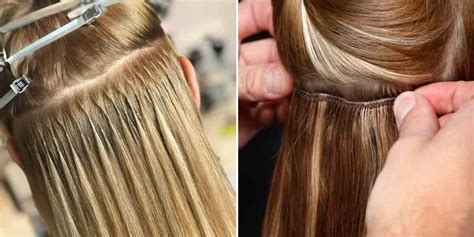The Growing Demand for Natural Hair Extensions
With the increasing popularity of natural hairstyles, the demand for high-quality hair extensions has skyrocketed. According to the American Hair Weavers & Braiders Association (AHWBA), the global hair extension market reached an estimated $8.5 billion in 2022, and is projected to grow to $12.1 billion by 2028. This surge in demand is driven by the desire for versatile, low-maintenance, and natural-looking hair extensions.

5 Types of Natural Hair Extensions
Natural hair extensions come in various types, each with its own unique benefits and drawbacks. Here are the five most popular options:
1. Clip-In Extensions (1-Minute Transformation):
- Easy and quick to apply and remove
- Available in a wide range of colors and lengths
- Gentle on hair, as they do not require glue or adhesives
2. Tape-In Extensions (6-Week Wear):
- Thin, adhesive-backed tapes that bond to natural hair
- Flatter and more discreet than other extension methods
- May cause damage to hair if not applied correctly
3. Sew-In Extensions (4-Month Hold):
- Strands of hair sewn into small sections of natural hair
- Long-lasting and secure
- Can be uncomfortable to wear for extended periods
4. Micro-Bead Extensions (2-3-Month Lifespan):
- Keratin-tipped extensions attached to natural hair using tiny beads
- Blends seamlessly with natural hair
- May be prone to slippage or breakage under tension
5. Fusion Extensions (4-6-Month Fusion):
- Extensions bonded to natural hair using heat-activated keratin
- Can create volume and length
- May cause heat damage to hair if applied improperly
Choosing the Ideal Extension Type
The best natural hair extension type for you depends on your specific needs and lifestyle. Consider factors such as:
- Desired length and volume: How much length and fullness do you want to add?
- Maintenance: How much time and effort are you willing to invest in maintaining the extensions?
- Budget: Natural hair extensions can range in price, so determine how much you’re comfortable spending.
- Hair health: Consult with a professional to assess your hair health and determine the most suitable extension method for you.
Professional Installation and Maintenance
For optimal results, it is crucial to have natural hair extensions installed and maintained by a certified professional. This ensures proper application, blending, and care to minimize damage to your natural hair.
Installation:
- Consultation: Discuss your desired length, volume, and budget with the stylist.
- Color matching: Select hair extensions that match your natural hair color and texture.
- Application: Apply the extensions using the chosen method, following proper techniques.
Maintenance:
- Brush extensions gently to prevent tangles.
- Wash extensions less frequently than natural hair to preserve moisture.
- Condition extensions regularly to keep them soft and shiny.
- Avoid heat styling as much as possible to minimize damage.
Pros and Cons of Different Extension Types
| Extension Type | Pros | Cons |
|---|---|---|
| Clip-In | Easy to apply and remove, versatile | Short lifespan, may not blend as well |
| Tape-In | Flatter, more discreet | May damage hair if not applied correctly |
| Sew-In | Long-lasting, secure | Can be uncomfortable to wear, may damage hair |
| Micro-Bead | Blends seamlessly with natural hair, customizable | Prone to slippage or breakage |
| Fusion | Volume and length, secure | May cause heat damage, difficult to remove |
Conclusion
Natural hair extensions offer a wide range of options to enhance your hair’s length, volume, and style. By carefully considering your needs and choosing the right extension type and installation method, you can achieve a natural and beautiful look that boosts your confidence and turns heads. Embrace the transformative power of natural hair extensions and unlock your hair’s full potential!
